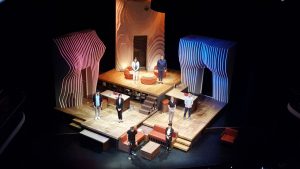Actor Training and Intercultural Jam in a Multilingual Context
March 30, 2020

In 1961, the International Theatre Institute (ITI) initiated World Theatre Day on 27th March, now celebrated by theatre practitioners, fans, and schools across the world. Each year, an outstanding figure in theatre or a person who is outstanding in heart and spirit from another field is invited to share their reflections on theatre and international harmony. This International Message is then translated into more than 50 languages and read for tens of thousands of spectators before performances in theatres throughout the world.
Assistant Professor Alvin Eng Hui Lim (NUS Department of English Language and Literature) examines two actor training methodologies and its challenges in helping Singaporean actors navigate through intercultural spaces in ‘Actor Training and Intercultural Jam in a Multilingual Context’ (Theatre, Dance and Performance Training, 2016). Dr Lim chose Nine Years Theatre (NYT) as a case study given their unique combination of training methods from Tadashi Suzuki’s Method of Actor Training and Anne Bogart’s Viewpoints. The training method challenges actors to juggle their personal identities – as a result of their predominantly Singapore-based cultural backgrounds – with the personas they play. Through interviews with NYT’s co-founders, Nelson Chia and Mia Chee, the physical demands and foreign language mediums of the programme are also to sharpen consciousness of both voice and body. For example, as part of the Viewpoints method, actors have to sing a Japanese song which becomes uneasy because not everyone understands the language; this forces them to focus on the stimuli provided by others to coordinate the group’s timing. Furthermore, the Suzuki method has a segment where actors stomp their feet based on a musical rhythm and then pose as sitting statues while reciting lines. The exercises physically strains the actors but deepens their awareness of their bodies, voices, and the interrelated components of a performance.
Dr Lim discovered that the overarching aim of the training approach is to arrive at a body of paradox. Despite the ostensibly out-of-place stomping and the use of Japanese, the actors were performing from a place of ease and comfort – which happens after the deconstruction and reconstruction of their cultural identities post-training. Dr Lim found that the training allowed actors to engage as well as cross cultural paradoxes so as to produce refreshing performances.
Read the article here: https://www.tandfonline.com/doi/abs/10.1080/19443927.2016.1143873?journalCode=rtdp20
